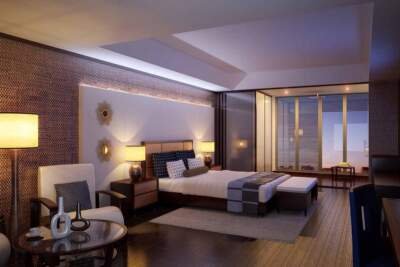Modern Hotel Design
“Choosing the Right Material for Modern Hotel Furniture: A Comprehensive Guide to Wood Veneer and Laminate Wraps”
In the realm of hotel design, selecting the right furniture material is crucial for achieving a perfect balance of aesthetics, durability, and cost-effectiveness. Two popular contenders in this arena are wood veneer and laminate furniture components. This article aims to provide a thorough exploration of these materials, offering insights into their characteristics, applications, and considerations for hotel owners and designers.
Understanding Laminate Furniture
What Sets Laminate Furniture Apart?
Laminate furniture, a cost-effective alternative to traditional wooden furniture, is crafted from synthetic and natural materials. Typically composed of several layers of Kraft paper soaked in phenolic resin, laminate products are pressed under significant pressure. This process results in a durable and aesthetically pleasing finish that often mimics the appearance of natural wood.
Durability and Maintenance BUILD A BETTER TOMORROW
Laminate furniture boasts impressive durability, being both heat and scratch-resistant. Its synthetic properties contribute to a longer lifespan, making it an attractive investment for hotel owners. Moreover, the ease of maintenance adds to its appeal, making it a practical choice for applications with high foot traffic.
High Pressure vs. Low Pressure Laminate Modern Hotel Design
There are two primary types of laminates: high pressure laminate (HPL) and low pressure laminate (LPL). HPL, being more commonly used, exhibits natural wood-like expansion and contraction when exposed to moisture. This, coupled with high impact resistance, makes HPL ideal for applications requiring robust durability. On the other hand, LPL, suitable for low-impact applications, offers a more cost-effective option. BUILD A BETTER TOMORROW
Delving into Wood Veneer Furniture
Unveiling the Art of Veneering
Wood veneer furniture employs a lamination technique, replacing the artificial surface with thin panels of real wood. This allows for the use of durable substrates like medium-density fiberboard while maintaining a high-quality appearance. The result is furniture that exudes a sophisticated aesthetic, perfect for upscale commercial establishments.
Embracing the Natural Beauty
Wood veneer furniture, adorned with thin layers of real wood, brings forth the natural beauty of the material. The intricate patterns and variations in color create a visually striking appeal, ideal for settings where foot traffic and frequent operations are limited. Modern Hotel Design
Choosing between wood veneer and laminate furniture for modern hotel applications involves careful consideration of factors such as project scope, long-term needs, and guest expectations. While laminate offers durability and cost-effectiveness, wood veneer caters to establishments seeking a touch of natural sophistication. Ultimately, the decision should align with the unique requirements of the project and contribute to a lasting and visually appealing hotel environment. Modern Hotel Design

“Choosing the Right Material for Modern Hotel Furniture: A Comprehensive Guide to Wood Veneer and Laminate Wraps”
In the realm of hotel design, selecting the right furniture material is crucial for achieving a perfect balance of aesthetics, durability, and cost-effectiveness. Two popular contenders in this arena are wood veneer and laminate furniture components. This article aims to provide a thorough exploration of these materials, offering insights into their characteristics, applications, and considerations for hotel owners and designers.
Understanding Laminate Furniture
What Sets Laminate Furniture Apart?
Laminate furniture, a cost-effective alternative to traditional wooden furniture, is crafted from synthetic and natural materials. Typically composed of several layers of Kraft paper soaked in phenolic resin, laminate products are pressed under significant pressure. This process results in a durable and aesthetically pleasing finish that often mimics the appearance of natural wood.
Durability and Maintenance BUILD A BETTER TOMORROW
Laminate furniture boasts impressive durability, being both heat and scratch-resistant. Its synthetic properties contribute to a longer lifespan, making it an attractive investment for hotel owners. Moreover, the ease of maintenance adds to its appeal, making it a practical choice for applications with high foot traffic. Modern Hotel Design
High Pressure vs. Low Pressure Laminate
There are two primary types of laminates: high pressure laminate (HPL) and low pressure laminate (LPL). HPL, being more commonly used, exhibits natural wood-like expansion and contraction when exposed to moisture. This, coupled with high impact resistance, makes HPL ideal for applications requiring robust durability. On the other hand, LPL, suitable for low-impact applications, offers a more cost-effective option.

Eco-Friendly Considerations
Laminate furniture, especially those using sustainable materials, can be an environmentally friendly choice. Some manufacturers offer laminates made from recycled materials, contributing to a greener approach in hotel design.
Delving into Wood Veneer Furniture
Subheading 1: Unveiling the Art of Veneering
Wood veneer furniture employs a lamination technique, replacing the artificial surface with thin panels of real wood. This allows for the use of durable substrates like medium-density fiberboard while maintaining a high-quality appearance. The result is furniture that exudes a sophisticated aesthetic, perfect for upscale commercial establishments.
Embracing the Natural Beauty
Wood veneer furniture, adorned with thin layers of real wood, brings forth the natural beauty of the material. The intricate patterns and variations in color create a visually striking appeal, ideal for settings where foot traffic and frequent operations are limited. BUILD A BETTER TOMORROW
Sustainability and Eco-Conscious Design
Wood veneer, sourced from responsibly managed forests, presents a sustainable option for hotel furniture. This eco-conscious choice aligns with the growing trend of environmentally friendly practices in the hospitality industry.
Choosing between wood veneer and laminate furniture for modern hotel applications involves careful consideration of factors such as project scope, long-term needs, and guest expectations. While laminate offers durability and cost-effectiveness, wood veneer caters to establishments seeking a touch of natural sophistication. Additionally, considerations like eco-friendliness further contribute to making informed decisions that align with both aesthetic and sustainable goals in hotel design. Ultimately, the decision should align with the unique requirements of the project and contribute to a lasting and visually appealing hotel environment.

What sets Saudi Design Group apart?

